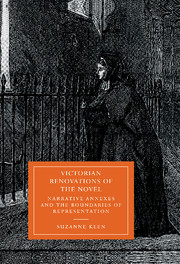Book contents
- Frontmatter
- Contents
- Acknowledgments
- 1 Narrative annexes: altered spaces, altered modes
- 2 Victorian critics, narrative annexes, and prescriptions for the novel
- 3 Norms and narrow spaces: the gendering of limits on representation
- 4 Narrative annexes, social mobility, and class anxiety
- 5 Older, deeper, further: narrative annexes and the extent of the Condition of England
- 6 Victorian annexes and modern form
- Notes
- Bibliography
- Index
- CAMBRIDGE STUDIES IN NINETEENTH-CENTURY LITERATURE AND CULTURE
6 - Victorian annexes and modern form
Published online by Cambridge University Press: 13 November 2009
- Frontmatter
- Contents
- Acknowledgments
- 1 Narrative annexes: altered spaces, altered modes
- 2 Victorian critics, narrative annexes, and prescriptions for the novel
- 3 Norms and narrow spaces: the gendering of limits on representation
- 4 Narrative annexes, social mobility, and class anxiety
- 5 Older, deeper, further: narrative annexes and the extent of the Condition of England
- 6 Victorian annexes and modern form
- Notes
- Bibliography
- Index
- CAMBRIDGE STUDIES IN NINETEENTH-CENTURY LITERATURE AND CULTURE
Summary
If you were not born in Arcadia, you linger in fancy on its margin; your thoughts are busy with the flutes of antiquity, with daffodils, and the classic poplar, and the footsteps of the nymphs, and the elegant and moving aridity of ancient art. Why dedicate to you a tale of a caste so modern; – full of details of our barbaric manners and unstable morals; – full of the need and the lust of money, so that there is scarce a page in which dollars do not jingle; – full of the unrest and movement of our century, so that the reader is hurried from place to place and sea to sea, and the book is less a romance than a panorama; – in the end, as blood-bespattered as an epic? … The tone of the age, its movement, the mingling of races and classes in the dollar hunt, the fiery and not quite unromantic struggle for existence with its changing trades and scenery, and two types in particular, that of the American handy-man of business and that of the Yankee merchant sailor – we agreed to dwell upon at some length … After we had invented at some expense of time this method of approaching and fortifying our police novel, it occurred to us it had been invented previously by someone else, and was in fact – however painfully different the results may seem – the method of Charles Dickens.
Robert Louis Stevenson and Lloyd Osbourne “Epilogue,” The Wrecker (1891)Throughout this study I have argued that metaphors of place, zone, and realm appear to be indispensable to the Victorians as they define and redefine the job of the novel.
- Type
- Chapter
- Information
- Victorian Renovations of the NovelNarrative Annexes and the Boundaries of Representation, pp. 178 - 189Publisher: Cambridge University PressPrint publication year: 1997

